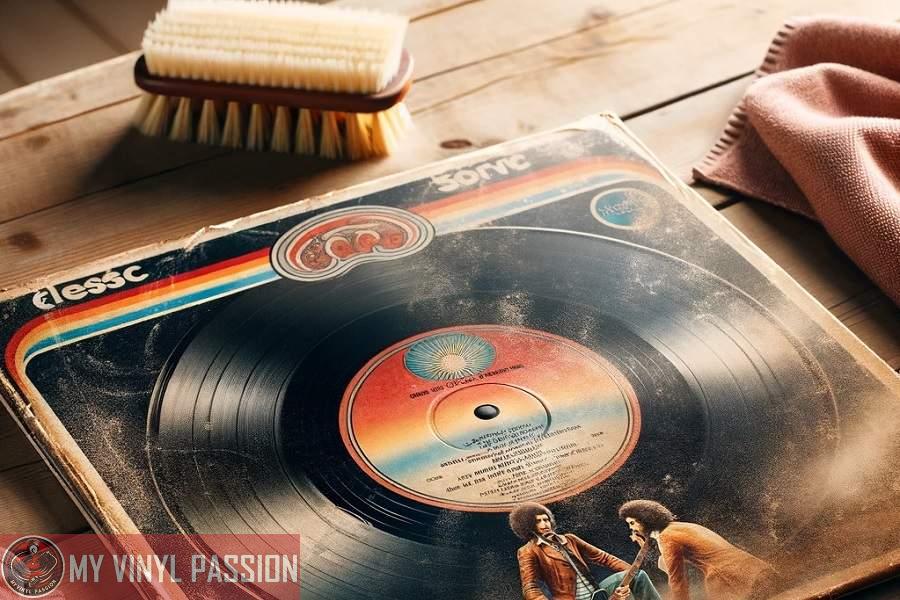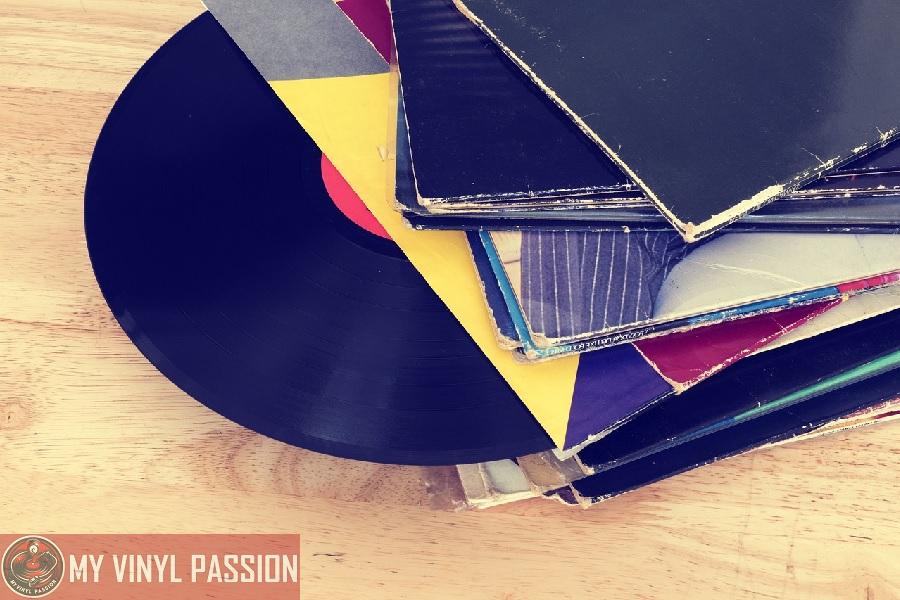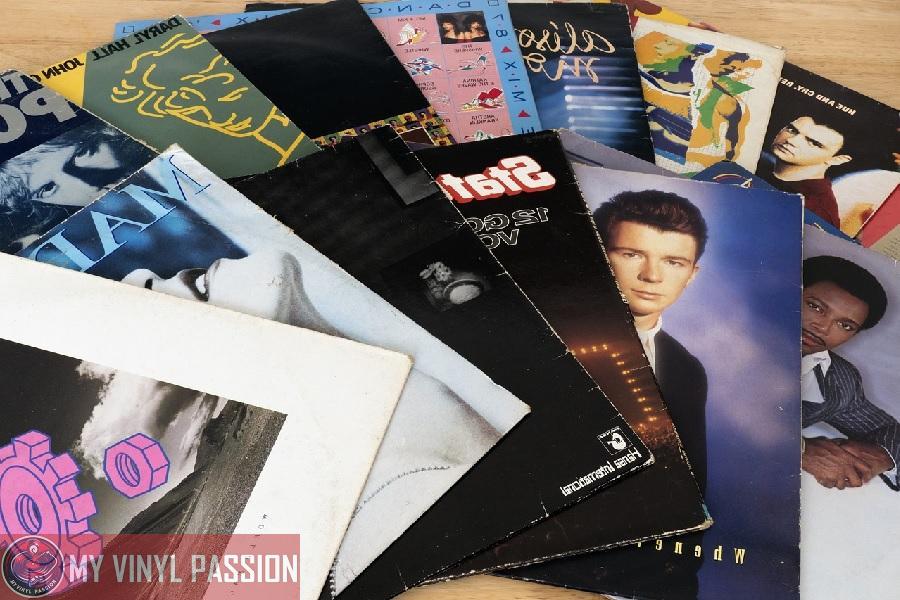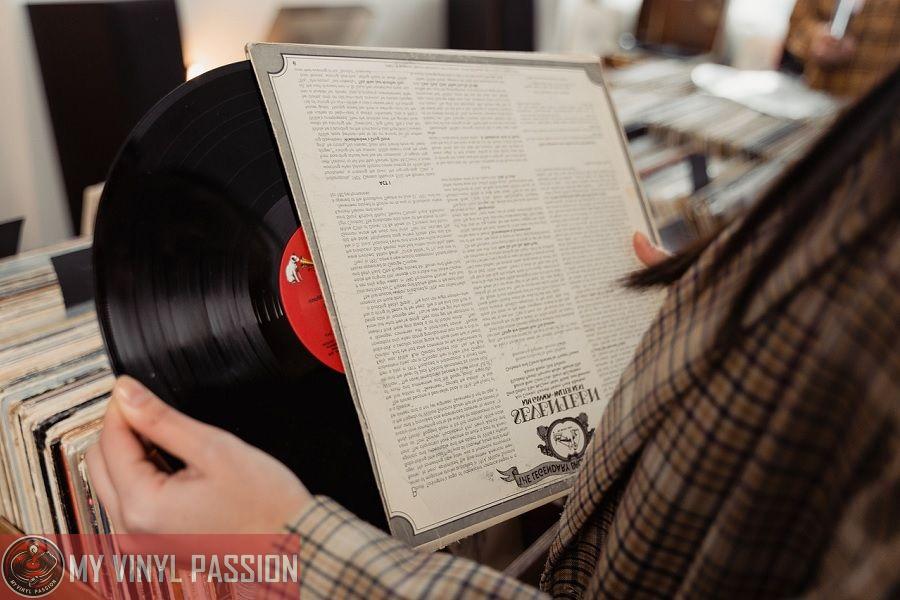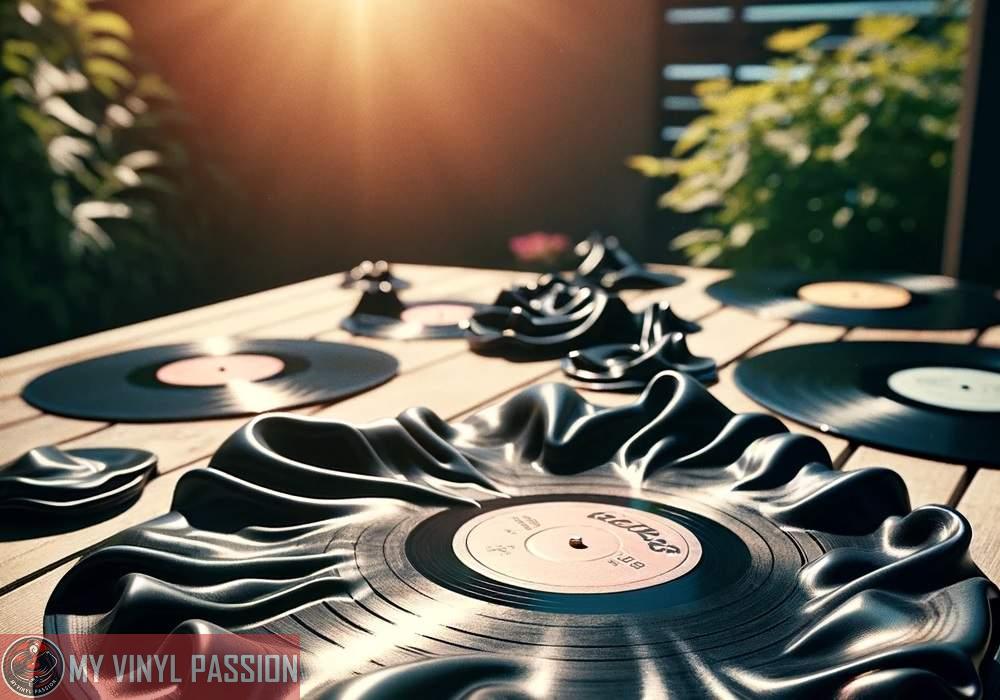Vinyl records have made a major comeback, and many music enthusiasts are rediscovering the charm of owning an impressive collection of these vintage treasures.
One challenge that many collectors face is properly preserving and maintaining the condition of not only the records themselves, but also their covers. Old vinyl record covers can collect dust, grime, and even mold over time.
In Summary
Familiarize yourself with the materials used in vinyl record covers to ensure proper care.
Gently wipe them with a soft, lint-free cloth dampened with a mixture of mild soap and lukewarm water, ensuring to avoid damaging the artwork, and then allow them to air-dry completely.
Proper drying and preservation techniques maintain the condition of your vinyl record covers over time.
Knowing how to clean them is essential to ensure that your collection remains in top-notch shape.
Cleaning old vinyl record covers may seem like a daunting task, but with the right tools and techniques, you can restore these delicate items to their former glory.
With a basic understanding of the materials used in vinyl record covers and taking some precautions before cleaning, you will be better equipped to tackle this process. It’s crucial to use gentle cleaning methods while addressing stubborn stains and preserving the cover’s condition for the long term.
Understanding Vinyl Record Covers
Types of Record Covers
When it comes to vinyl record covers, understanding the different types is crucial. There are generally two common types: laminated and glossy. Laminated covers feature a thin layer of plastic coating that offers protection against wear and tear. On the other hand, glossy covers have a shiny finish, but lack the plastic layer.
- Laminated: Protective plastic coating.
- Glossy: Shiny finish but without protection.
Common Issues Faced by Vinyl Covers
Just like the vinyl records themselves, the covers can also experience various issues, such as seam splits, cut corners, mold, mildew, and dirt build-up. As a collector, you should be aware of these issues to ensure the longevity of your collection.
Seam Splits
One of the most common issues faced by vinyl record covers is seam splits. These occur when the edges of the cover separate due to wear and tear or mishandling. They can be particularly problematic for both laminated and glossy covers.
Cut Corners
Cut corners can happen when retailers or distributors mark an album as a promotional item, discount, or a cut-out. They typically cut the corners of the covers to indicate that the album is not in prime condition.
Mold and Mildew
Another issue that vinyl record covers can face is the growth of mold and mildew. This usually occurs in damp environments where moisture is present. Both mold and mildew can damage the cover and the record, so it’s essential to store your vinyl records in a dry and cool place.
Dirt Build-up
Dirt can accumulate on vinyl record covers over time, especially if they are frequently handled or not stored properly. Regular cleaning can help prevent build-up and keep your collection in good condition.
To better preserve your vinyl records and their covers, ensure that they are stored in a cool, dry environment, away from direct sunlight. This will help prevent issues like moisture damage and sun exposure, which can lead to fading and warping.
By taking these precautions, you can extend the life of your precious vinyl collection and enjoy it for years to come.
Pre-Cleaning Preparations
Gathering Necessary Materials
Before you start cleaning your old vinyl record covers, it’s important to gather all the necessary materials. You’ll need a microfiber cloth, a cleaning solution, and a cleaning brush. A toothbrush can also come in handy for tight spots or textured surfaces.
For the cleaning solution, a mixture of distilled water and a mild soap is recommended, as it is gentle enough for delicate record covers. You can also use a specialized record cleaning solution for optimal results.
Prepare a clean, dry surface to work on and have some towels on hand to place the covers on after cleaning. Additionally, disinfecting wipes can be used to wipe down the exteriors of the covers before you begin the deep cleaning process.
Once you have all the necessary materials, you can begin cleaning your old vinyl record covers. Remember to always take precautions and test the cleaning solution on a small, inconspicuous area of the cover before applying it to the entire surface.
This will help ensure you don’t accidentally damage the cover or cause any unwanted reactions between the solution and the cover material.
With the right materials and a careful approach, you can effectively clean old vinyl record covers and help preserve their beauty and value for years to come.
Cleaning Procedure for Vinyl Record Covers
Dry Cleaning Techniques
To remove dust and debris from your old vinyl record covers, start by using a soft-bristled brush. Gently brush the surface in short strokes to dislodge any loose particles. A microfiber cleaning cloth is also effective for this purpose, as it can pick up dust without scratching the cover.
For a more thorough cleaning, consider using an anti-static carbon fiber brush to eliminate static electricity buildup, which can attract more dust. To use this type of brush, gently swipe it across the cover surface, taking care not to press too hard or damage the artwork.
Wet Cleaning Methods
When dealing with more stubborn dirt, mildew, or mold on your vinyl record covers, a wet cleaning method may be necessary. Before proceeding, ensure the use of non-abrasive and gentle cleaning products to protect your album art.
- Testing: Before applying any cleaning solution to the entire cover, test a small, inconspicuous area to check for any adverse reactions or damage to the artwork.
- Application: After testing, apply the cleaning solution to a lint-free cloth and gently clean the cover, taking care to avoid the center label.
- Removing excess water: Once you have cleaned the cover, remove any excess water with a clean, dry cloth. Be mindful not to rub too hard, as this might cause damage to the artwork.
- Drying: Allow the vinyl record cover to air dry completely before placing it back in its protective sleeve to prevent the growth of mold and mildew.
By using these dry and wet cleaning techniques, you can effectively clean and preserve your old vinyl record covers, ensuring their longevity and visual appeal. Remember to always handle your album covers with care, using gentle, non-abrasive materials and cleaning products to maintain their pristine condition.
Addressing Stubborn Stains and Marks
Removing Adhesive Residue
If your old vinyl record covers have stubborn adhesive residue, don’t worry. Try applying a small amount of rubbing alcohol to a soft, lint-free cloth and gently rub the affected area in a circular motion.
Be sure to test a small hidden area first to ensure the rubbing alcohol won’t damage the cover. Once the adhesive is removed, wipe the area with a clean, damp cloth to remove any remaining alcohol, and allow it to air dry.
Treating Water Damage
Water damage can leave marks and cause discoloration on vinyl record covers. To address this issue, start by laying your record cover flat on a clean surface and use a soft, lint-free cloth or towel to gently dab the moisture. Be sure not to rub the cover, as this can cause further damage.
If the cover is heavily soiled, you can create a solution of warm water and a few drops of mild detergent. Use a soft-bristle brush to gently scrub the affected areas, then rinse the cover with a clean, damp cloth. Always avoid soaking the covers in water, as this can lead to irreversible damage.
After removing dirt and moisture, place the cover between two clean, dry towels to absorb excess water. Finally, allow your record cover to air dry completely in a well-ventilated area, away from direct sunlight or heat sources.
To ensure the long-term preservation of your vinyl record covers, store them in a cool, dry environment, and consider using plastic sleeves for added protection.
Remember that regular maintenance, such as dusting and spot-cleaning, can help prevent damage from dirt and moisture. With proper care, your vinyl record covers will remain in great condition for years to come.
Drying and Preservation Techniques
Air Drying Process
After cleaning your vinyl record covers, it is essential to let them air dry. Use a clean, dry surface to lay your covers on and avoid stacking them while they’re still wet. If possible, find a well-ventilated area to speed up the drying process.
Another useful tool is a microfiber towel. You can gently press the towel against the cover to absorb excess moisture, but make sure not to rub the surface, as this may cause damage.
Long-Term Storage Recommendations
As a vinyl collector, preserving your record collection is crucial. For long-term storage, consider placing your dried vinyl covers in anti-static sleeves. These sleeves help reduce the buildup of static electricity, which can attract dust and dirt over time.
Additionally, keep your collection in an environment with consistent temperature and humidity levels to prevent warping or deterioration.
Here are some recommendations for storing your vinyl record covers:
- Always store your records vertically, and never stack them on top of each other.
- Maintain a temperature between 60-75°F (15-24°C) and a relative humidity around 50%.
- Avoid storing in direct sunlight, as it may cause fading or warping.
For efficient organization and management of your vinyl collection, separate records into batches based on categories such as genre, artist, or release date. This method will help you quickly locate and enjoy your records while also ensuring that you properly maintain them over time.
Invest in a good quality storage solution, such as dedicated shelving or cabinets that provide a stable, secure environment for your records.
Properly storing and caring for your vinyl record covers will ensure that your collection stays in pristine condition, making it more enjoyable for you and future generations of vinyl enthusiasts.
Advanced Cleaning Equipment
Using Record Cleaning Machines
Record cleaning machines can greatly improve the process of maintaining your vinyl collection. These machines work by applying a cleaning solution to the surface of the record and then using a vacuum or brush mechanism to remove dust, dirt, and grime.
One popular option is the Spin-Clean system, which is a manual device that gently cleans the grooves of your records with the help of a cleaning solution.
When using a record cleaning machine, it is crucial to follow the manufacturer’s instructions. Proper use will ensure the best results and avoid damage to your valuable collection.
Ensure that you have a clean, lint-free drying rack available to dry your records after they have been cleaned to prevent any residue or water spots.
The Role of Sprays and Solutions
The key to effective record cleaning lies in the cleaning solution. A variety of sprays and cleaning solutions are on the market, each claiming to provide the best results. It is crucial to choose a solution specifically created for vinyl records.
These solutions are designed to break down dirt and grime without compromising the delicate grooves.
When using a cleaning spray, remember to never apply it directly to the record surface. Instead, apply it to a microfiber cloth or cleaning brush first, and then gently clean the record in a circular motion, following the grooves.
This technique will ensure that the cleaning solution penetrates the grooves without harming your record.
In addition to cleaning sprays, consider investing in a vinyl record cleaning kit, which typically includes a cleaning solution, a brush, and a drying cloth. These kits provide a comprehensive solution for maintaining your collection and prolonging the life of your records.
By incorporating advanced cleaning equipment and methods into your vinyl care routine, you can confidently enjoy the high-quality sound and appearance of your cherished collection.
Maintaining Vinyl Record Cover Condition
Maintaining your vinyl records in pristine condition is important not only for sound quality but also for preserving their value. The key to a clean vinyl collection lies in proper maintenance of both the record and its cover.
To ensure that your record covers stay in top shape, start by handling them with care. Hold them by the edges and avoid touching the artwork with your fingers, as fingerprint oils can damage the cover over time.
Store your records vertically to prevent damage to the covers. Stacking them horizontally can result in dents or creases, while standing them up like books minimizes stress on the covers. Be sure not to pack them too tightly, as this may cause warping or bending over time.
In addition to careful handling and storage, it’s crucial to clean your vinyl records and covers regularly. Here’s a suggested cleaning routine for your vinyl collection:
- Dust off covers: Before cleaning the vinyl records themselves, gently remove any dust from the covers using a soft, dry cloth or a vinyl brush designed specifically for record covers.
- Clean vinyl records: Adopt a routine for cleaning your vinyl records to keep them in optimal condition. Experts recommend cleaning vinyl records every third to fourth play or whenever they appear visibly dirty.
- Inspect for damage: While cleaning, take note of any tears, creases, or signs of wear on the covers. If repair is necessary, use acid-free tape or seek professional help to avoid worsening the damage.
Using the right materials for cleaning is essential to avoid damaging your record covers. Steer clear of any harsh chemicals, such as rubbing alcohol, as they can strip the ink or cause discoloration.
Instead, opt for a gentle, diluted soapy water solution to clean your vinyl record covers. Be sure to use a soft, lint-free cloth and remove any excess moisture to prevent water damage.
By following these steps, you can keep your vinyl collection in impeccable condition and preserve the value and aesthetic appeal of your beloved records for years to come.
Frequently Asked Questions
What are the safest cleaning solutions for old vinyl record covers?
To clean old vinyl record covers safely, it’s best to use a gentle, non-abrasive solution. A mixture of mild dish soap and lukewarm water is often recommended for cleaning album covers. Lightly dampen a soft, lint-free cloth with the soapy water and gently wipe the cover, taking care to avoid any damage to the artwork. After cleaning, wipe the cover with a dry cloth and let it air-dry completely.
Can you repair torn or damaged vinyl record covers, and if so, how?
You can repair torn or damaged vinyl record covers with some care and patience. One method involves using acid-free adhesive tape or thin linen-based tape available at specialty stores. Carefully align the torn edges and apply the tape on the inside of the cover, ensuring that the tape doesn’t show on the outside. For damaged corners, use cardstock to reinforce the area and secure it with adhesive.
How can you remove musty odors from vintage album covers?
To remove musty odors from vintage album covers, place the affected items in a well-ventilated area, avoiding direct sunlight. You may also try using baking soda by placing the album in a sealable bag with a few tablespoons of baking soda and leaving it for a few days. Be careful to not directly expose the album to baking soda, as it may cause damage. You can also use charcoal or activated carbon as a deodorizing agent to absorb unpleasant odors.
Is there a way to effectively remove stains from old vinyl record covers?
Removing stains from old vinyl record covers can be challenging, but not impossible. Start by gently wiping the stain with a soft cloth dampened with lukewarm water, avoiding any artwork. If the stain persists, try using a diluted solution of mild dish soap, vinegar, or rubbing alcohol, testing it on an inconspicuous area first to ensure the solution doesn’t damage the cover. Remember to blot, rather than scrubbing the stain, to minimize the risk of further damage.
What protective measures can be taken to preserve vinyl record covers?
To preserve vinyl record covers, store them vertically in a cool, dry, and dark environment, away from direct sunlight and high humidity. Invest in quality archival-quality outer sleeves made of acid-free polyethylene or similar materials to prevent dust and moisture damage. You might also consider using inner sleeves to protect the vinyl discs themselves. Additionally, avoid stacking albums and refrain from handling the covers with dirty or greasy hands.
How do different cleaning methods impact the value of vintage albums?
Improper cleaning methods, such as using abrasive chemicals or scrubbing the covers, can severely diminish the value of vintage albums. On the other hand, gentle and non-abrasive cleaning methods can help maintain or even enhance the value by preserving the cover’s artwork and overall condition. Always ensure you are using the most appropriate cleaning materials and techniques to avoid any potential damage.
